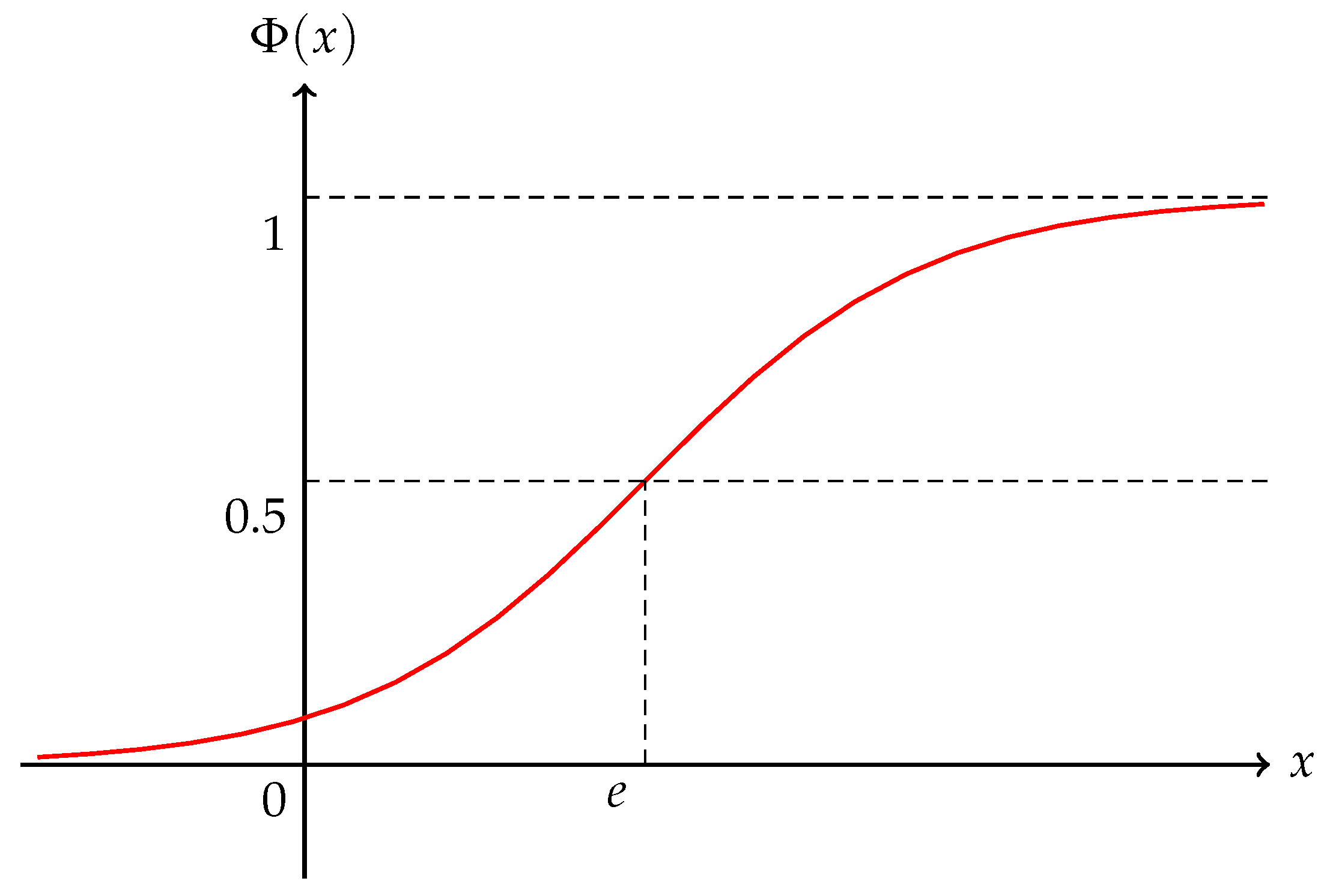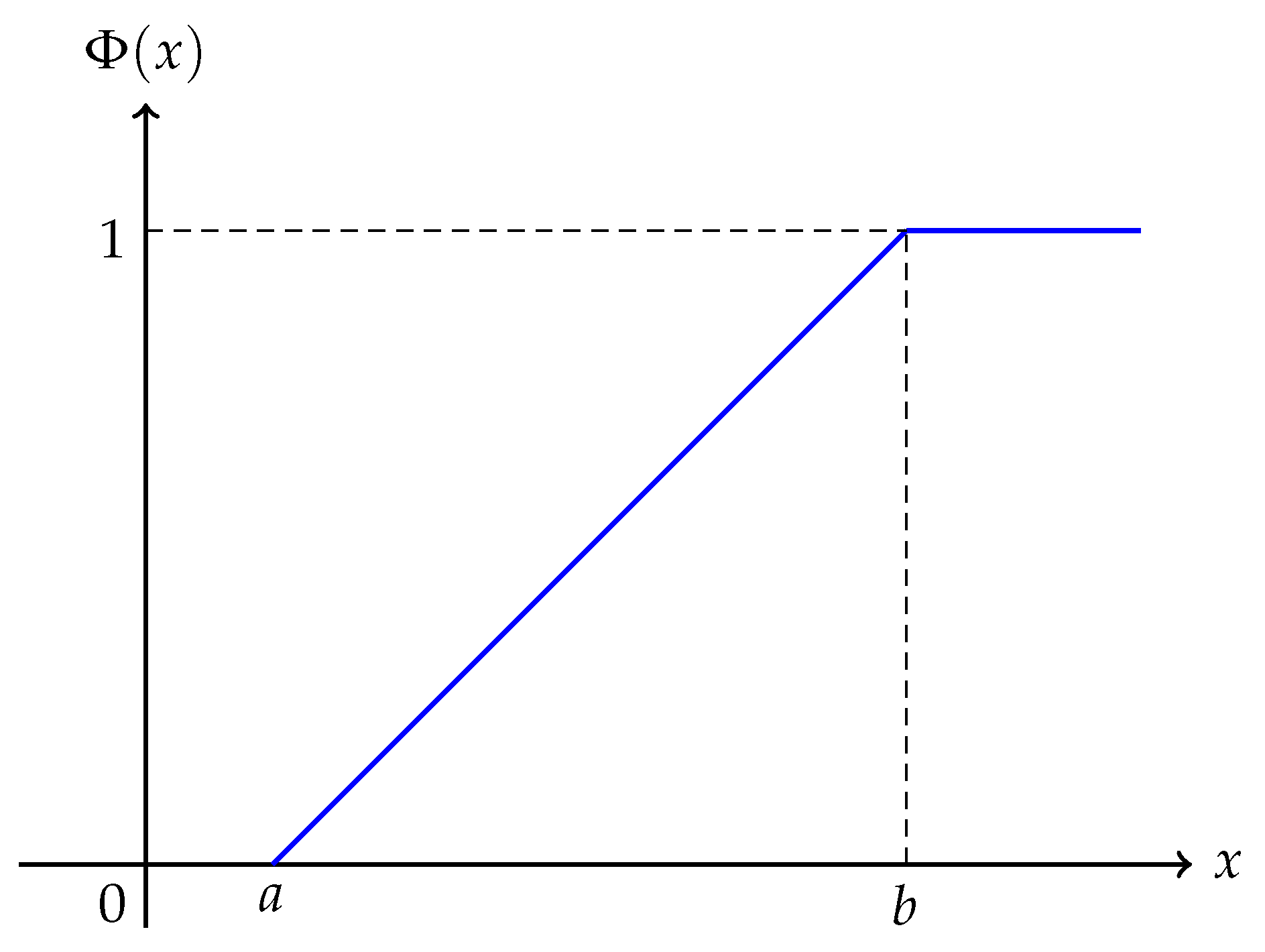On the Entropy and the Maximum Entropy Principle of Uncertain Variables
Abstract
1. Introduction
2. Preliminaries
2.1. Some Primary Facts in Uncertainty Theory
- 1.
- Normality: ;
- 2.
- Duality: for each event A;
- 3.
- Subadditivity: for each sequence of events , one gets
2.2. Necessary Results of the Generalized Inverse of an Increasing Function
2.3. Entropy Formula and the Principle of Maximum Entropy
3. Results
- 1.
- 2.
4. Proof of Theorem 9, Theorem 10, and Theorem 11
- (a)
- means
- (b)
- means
5. Proof of Proposition 1, Proposition 2, and Proposition 3
6. Discussion
- (1)
- Develop the entropy formula and the maximum entropy principle of an uncertain set;
- (2)
- Establish the entropy formula and research the maximum entropy distributions of uncertain random variables.
Author Contributions
Funding
Institutional Review Board Statement
Conflicts of Interest
References
- Shannon, C. A mathematical theory of communication. Bell Syst. Tech. J. 1948, 27, 379–423. [Google Scholar] [CrossRef]
- Gray, R.M. Entropy and Information Theory; Springer Science & Business Media: Berlin/Heidelberg, Germany, 2011. [Google Scholar]
- Kolmogorov, A. New metric invariant of transitive dynamical systems and endomorphisms of lebesgue spaces. Dokl. Russ. Acad. Sci. 1958, 119, 861–864. [Google Scholar]
- Liu, B. Some research problems in uncertainty theory. J. Uncertain Syst. 2009, 3, 3–10. [Google Scholar]
- Malakar, N.K.; Knuth, K.H.; Lary, D.J. Maximum joint entropy and information-based collaboration of automated learning machines. In AIP Conference Proceedings 31st; American Institute of Physics: College Park, MD, USA, 2012; Volume 1443, pp. 230–237. [Google Scholar] [CrossRef]
- Martin, N.F.; Engl, J.W. Mathematical Theory of Entropy (No.12); Cambridge University Press: Cambridge, UK, 2011. [Google Scholar]
- Walters, P. An Introduction to Ergodic Theory; Springer: Berlin/Heidelberg, Germany, 2000. [Google Scholar]
- Einsiedler, M.; Thomas, W. Ergodic Theory; Springer: London, UK, 2013. [Google Scholar]
- Liu, B. Uncertainty Theory, 4th ed.; Springer: Berlin/Heidelberg, Germany, 2015. [Google Scholar]
- Jaynes, E. Information theory and statistical mechanics. Phys. Rev. 1957, 106, 620–630. [Google Scholar] [CrossRef]
- Jaynes, E. Information theory and statistical mechanics. ii. Phys. Rev. 1957, 108, 171–190. [Google Scholar] [CrossRef]
- Polpo, A.; Stern, J.; Louzada, F.; Izbicki, R.; Takada, H. Bayesian Inference and Maximum Entropy Methods in Science and Engineering; Springer Proceedings in Mathematics & Statistics: Berlin/Heidelberg, Germany, 2018. [Google Scholar]
- Buckley, J.J. Entropy principles in decision making under risk. Risk Anal. 1985, 5, 303–313. [Google Scholar] [CrossRef]
- Hoefer, M.P.; Ahmed, S.B. The Maximum Entropy Principle in Decision Making Under Uncertainty: Special Cases Applicable to Developing Technologies. Am. J. Math. Manag. Sci. 1990, 10, 261–273. [Google Scholar] [CrossRef]
- Clarke, B. Information optimality and Bayesian modelling. J. Econom. 2007, 138, 405–429. [Google Scholar] [CrossRef]
- Naidu, P.S. Modern Spectrum Analysis of Time Series: Fast Algorithms and Error Control Techniques; CRC Press: Boca Raton, FL, USA, 1995. [Google Scholar]
- Zhang, Y. Principle of maximum entropy for reliability analysis in the design of machine components. Front. Mech. Eng. 2019, 14, 21–32. [Google Scholar] [CrossRef]
- Zu, T.; Kang, R.; Wen, M.; Zhang, Q. Belief reliability distribution based on maximum entropy principle. IEEE Access 2017, 6, 1577–1582. [Google Scholar] [CrossRef]
- Abbas, A.E.H.; Cadenbach, A.; Salimi, E. A Kullback–Leibler view of maximum entropy and maximum log-probability methods. Entropy 2017, 19, 232. [Google Scholar] [CrossRef]
- Liu, B. Uncertainty Theory, 2nd ed.; Springer: Berlin/Heidelberg, Germany, 2007. [Google Scholar] [CrossRef]
- Peng, Z.; Iwamura, K. A sufficient and necessary condition of uncertainty distribution. J. Interdiscip. Math. 2010, 13, 277–285. [Google Scholar] [CrossRef]
- Liu, Y.; Lio, W. A revision of sufficient and necessary condition of uncertainty distribution. J. Intell. Fuzzy Syst. 2020, 38, 4845–4854. [Google Scholar] [CrossRef]
- Yao, K. A formula to calculate the variance of uncertain variable. Soft Comput. 2015, 19, 2947–2953. [Google Scholar] [CrossRef]
- Sheng, Y.; Kar, S. Some results of moments of uncertain variable through inverse uncertainty distribution. Fuzzy Optim. Decis. Mak. 2015, 14, 57–76. [Google Scholar] [CrossRef]
- Chen, X.; Dai, W. Maximum entropy principle for uncertain variables. Int. J. Fuzzy Syst. 2011, 13, 232–236. [Google Scholar]
- Dai, W.; Chen, X. Entropy of function of uncertain variables. Math. Comput. Model. 2012, 5, 54–760. [Google Scholar] [CrossRef]
- Yao, K.; Gao, J.; Dai, W. Sine entropy for uncertain variable. Int. J. Uncertain. Fuzziness Knowl. Based Syst. 2013, 21, 743–753. [Google Scholar] [CrossRef]
- Tang, W.; Gao, W. Triangular entropy of uncertain variables. International Information Institute (Tokyo). Information 2013, 16, 1279. [Google Scholar]
- Ning, Y.; Ke, H.; Fu, Z. Triangular entropy of uncertain variables with application to portfolio selection. Soft Comput. 2015, 19, 2203–2209. [Google Scholar] [CrossRef]
- Dai, W. Quadratic entropy of uncertain variables. Soft Comput. 2018, 22, 5699–5706. [Google Scholar] [CrossRef]
- Ma, G. A remark on the maximum entropy principle in uncertainty theory. Soft Comput. 2021, 25, 13911–13920. [Google Scholar] [CrossRef]
- Liu, B. Uncertainty Theory: A Branch of Mathematics for Modeling Human Uncertainty; Springer: Berlin/Heidelberg, Germany, 2010. [Google Scholar]
- Embrechts, P.; Hofert, M. A note on generalized inverses. Math. Methods Oper. Res. 2013, 77, 423–432. [Google Scholar] [CrossRef]
- Resnick, S.I. Extreme Values, Regular Variation, and Point Processes (Vol. 4); Springer Science Business Media: Berlin/Heidelberg, Germany, 2008. [Google Scholar]
- Kämpke, T.; Radermacher, F.J. Income modeling and balancing. In Lecture Notes in Economics and Mathematical Systems; Springer: Berlin/Heidelberg, Germany, 2015. [Google Scholar]
- Iritani, J.; Kuga, K. Duality between the Lorenz curves and the income distribution functions. Econ. Stud. Q. (Tokyo 1950) 1983, 34, 9–21. [Google Scholar]
- Falkner, N.; Teschl, G. On the substitution rule for Lebesgue–Stieltjes integrals. Expo. Math. 2012, 30, 412–418. [Google Scholar] [CrossRef]
- Lebesgue, H. Sur l’integrale de stieltjes et sur les operérations fonctionelles linéaires. CR Acad. Sci. Paris 1910, 150, 86–88. [Google Scholar]
- Ma, G.; Yang, X.; Yao, X. A relation between moments of Liu process and Bernoulli numbers. Fuzzy Optim. Decis. Mak. 2021, 20, 261–272. [Google Scholar] [CrossRef]


Disclaimer/Publisher’s Note: The statements, opinions and data contained in all publications are solely those of the individual author(s) and contributor(s) and not of MDPI and/or the editor(s). MDPI and/or the editor(s) disclaim responsibility for any injury to people or property resulting from any ideas, methods, instructions or products referred to in the content. |
© 2023 by the authors. Licensee MDPI, Basel, Switzerland. This article is an open access article distributed under the terms and conditions of the Creative Commons Attribution (CC BY) license (https://creativecommons.org/licenses/by/4.0/).
Share and Cite
Liu, Y.; Ma, G. On the Entropy and the Maximum Entropy Principle of Uncertain Variables. Entropy 2023, 25, 1195. https://doi.org/10.3390/e25081195
Liu Y, Ma G. On the Entropy and the Maximum Entropy Principle of Uncertain Variables. Entropy. 2023; 25(8):1195. https://doi.org/10.3390/e25081195
Chicago/Turabian StyleLiu, Yujun, and Guanzhong Ma. 2023. "On the Entropy and the Maximum Entropy Principle of Uncertain Variables" Entropy 25, no. 8: 1195. https://doi.org/10.3390/e25081195
APA StyleLiu, Y., & Ma, G. (2023). On the Entropy and the Maximum Entropy Principle of Uncertain Variables. Entropy, 25(8), 1195. https://doi.org/10.3390/e25081195



